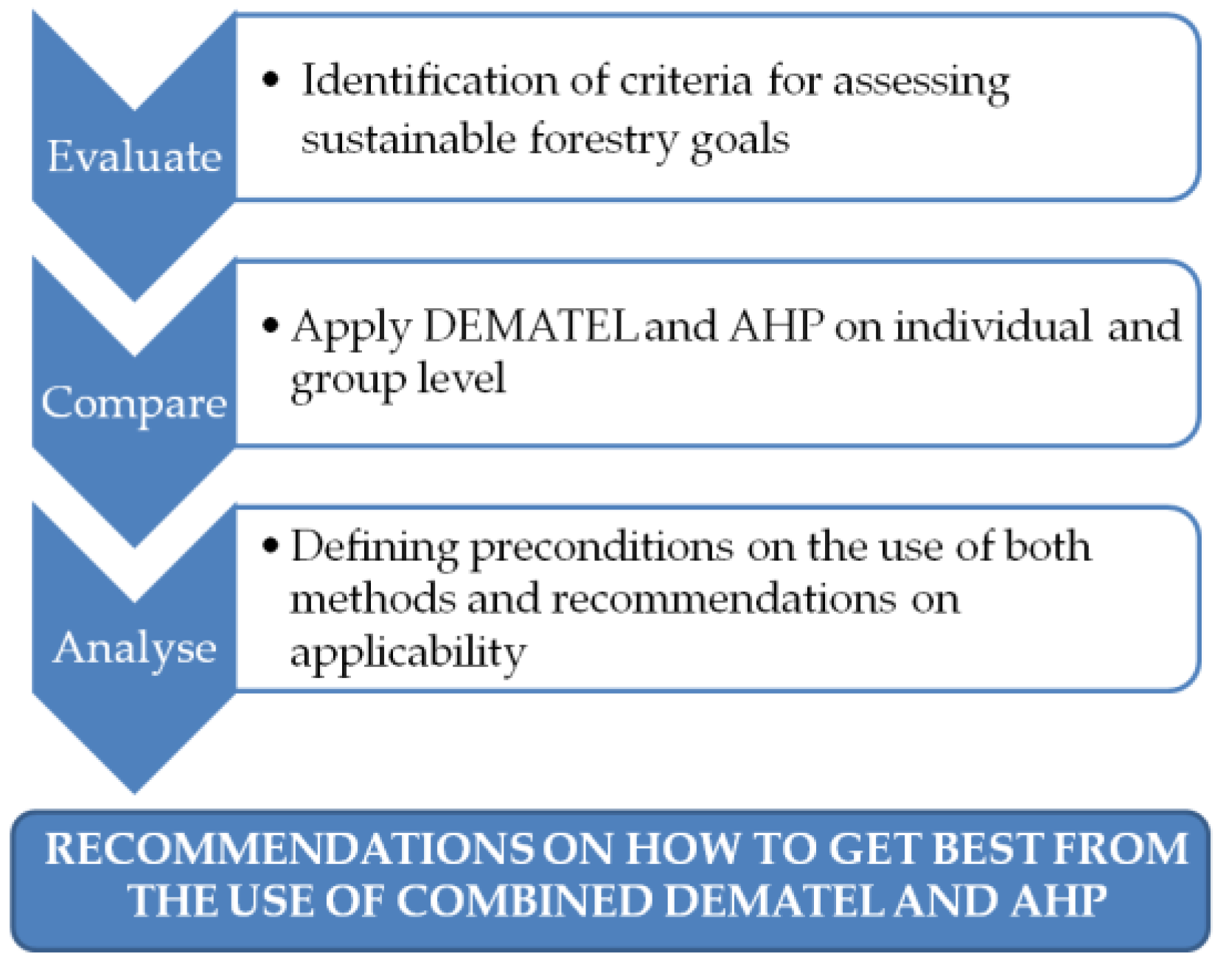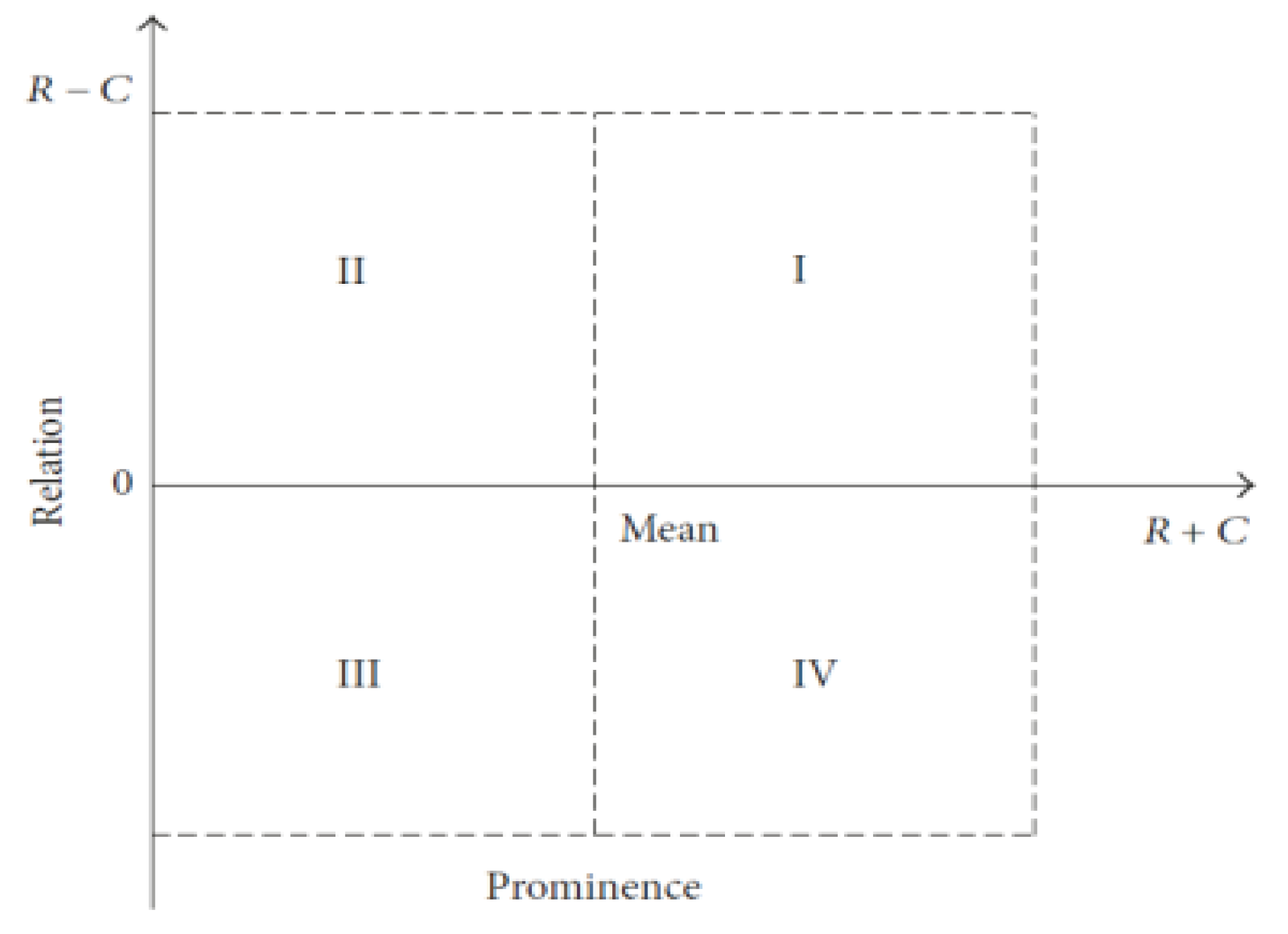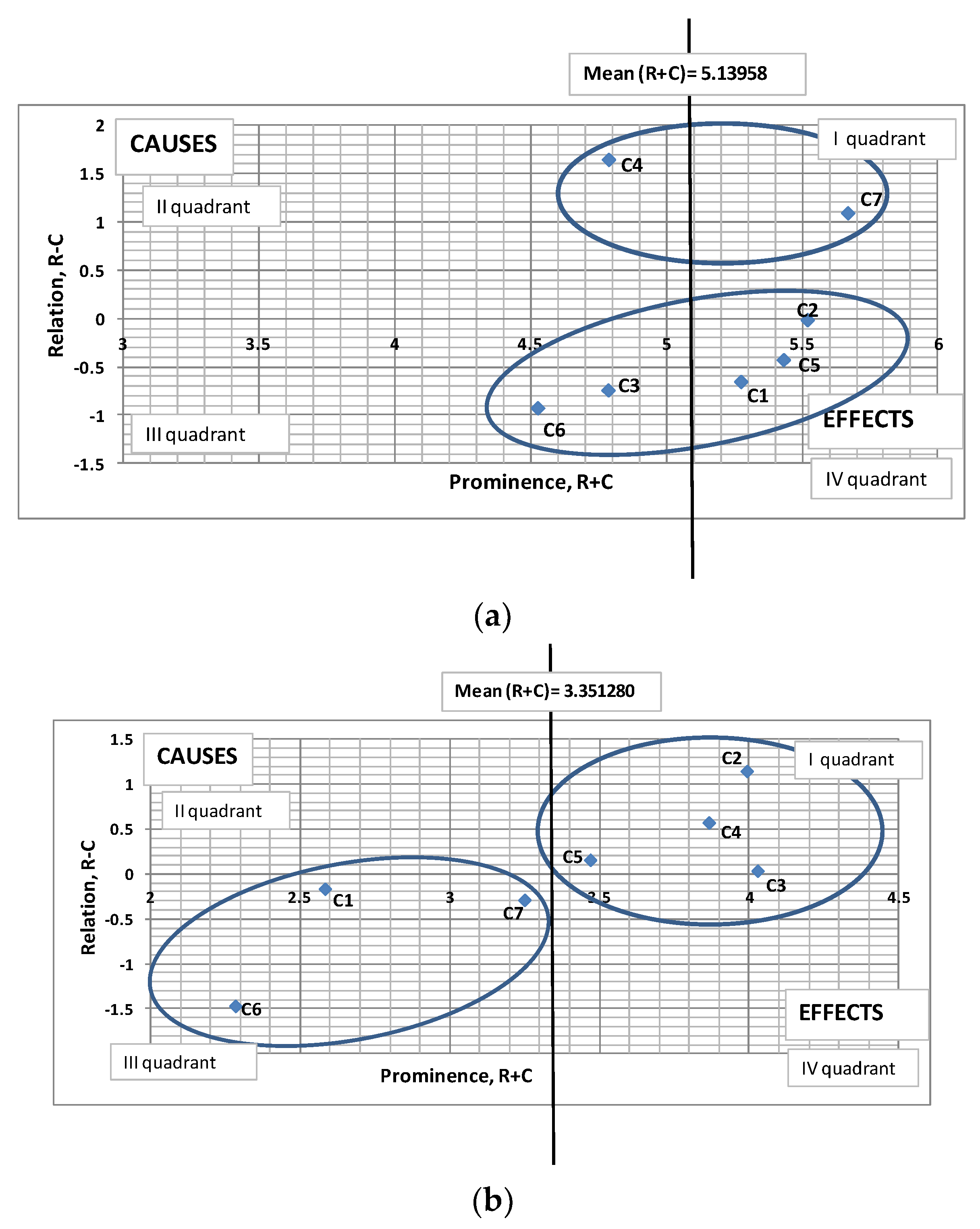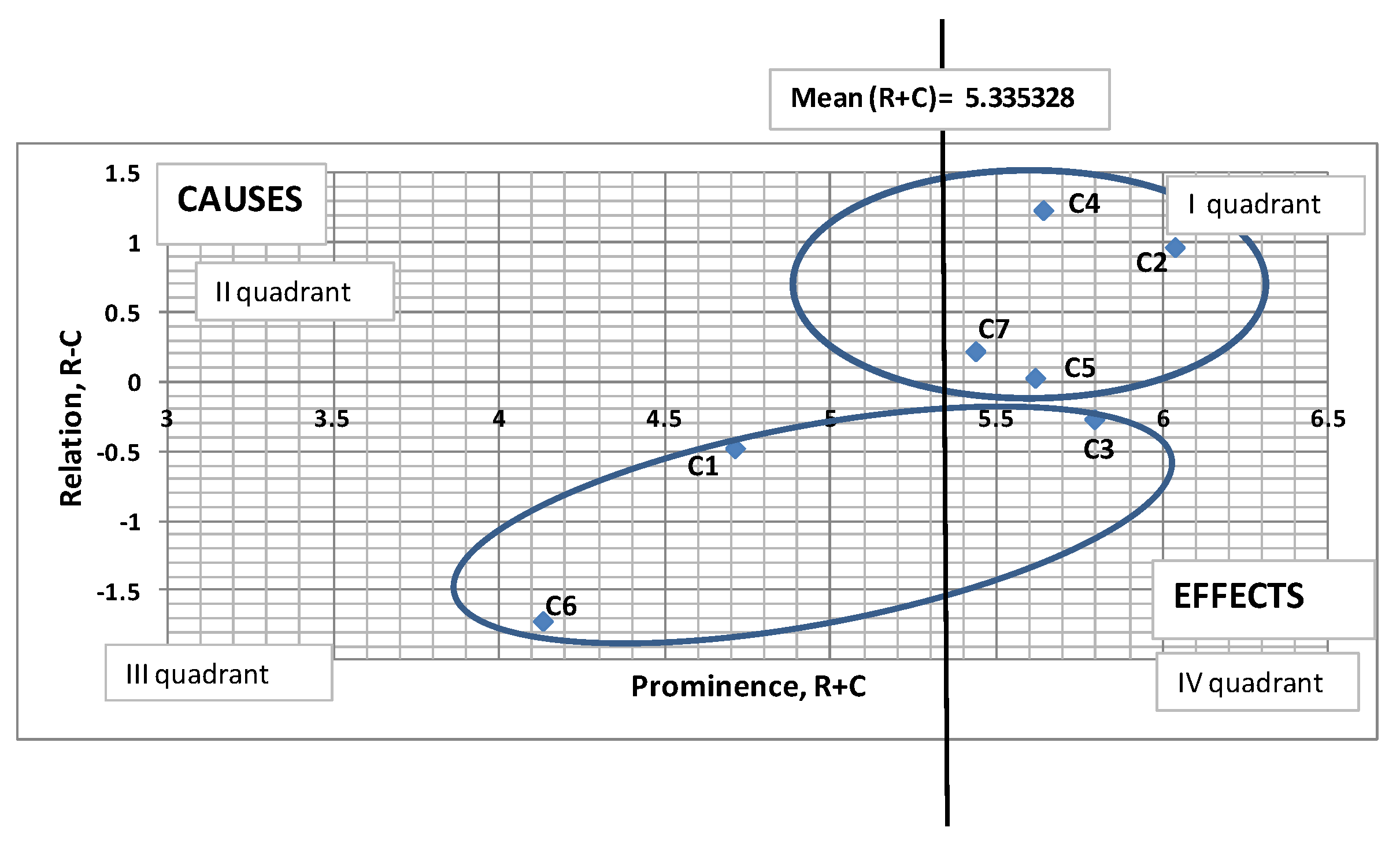The DEMATEL (DEcision-MAking Trial and Evaluation Laboratory) is developed by the Science and Human Affairs Program of the Battelle Memorial Institute of Geneva between 1972 and 1976. Its original idea was to enable the description and understanding of contextual relations and identify the cause-effect chain of components/factors for a complex decision problem [
20,
21]. Since its original introduction in the field of societal systems and sciences, the DEMATEL applications extremely dispersed in almost all fields of science and technology. The result is thousands of research and professional reports on its adjustments, mathematical and methodological shifts from crisp to fuzzy and rough representations, combined uses with other multi-criteria methods, individual and group applications, etc. In an analysis of decision problems, DEMATEL is used to recognize the interactions between the factors and to categorize factors into ‘cause’ and ‘effect’ groups [
38]. More details about the method are found in the research of Li et al. [
39]. For a given system DEMATEL identifies the critical factors that have the greatest influence on other factors and maps relations between factors thus providing the analysts with indicators of how to manage the system, its operation, or divisions into subsystems, better controllable and/or observable. Causal relations between factors, such as cause-effect relations, have fundamental importance for the decision-making process. One of the critical issues in assessing alternative solutions is how they perform concerning a given set of objectives or criteria. In most cases, this is related to solving a multi-criteria optimization problem (MCOP) for which it is required to previously allocate weights to the objectives/criteria respecting their importance regarding certain preference schemes, strategies, or else. Furthermore, the association of weights to objectives/criteria set most often assumes that elements in this set are mutually independent. The decision-maker compares these elements and eventually from afar considers the fact that some elements are “cause” and others are “effect” while playing in the same game which assumes their causal independence.
In the MCOP context, the role of DEMATEL can be understood as an efficient framework to recognize causality among elements (e.g., criteria) within a system (e.g., decision problem). The causal diagram can be acquired in DEMATEL by mapping criteria in a proper way so the decision maker can identify the most influential criteria, distinguish cause from effect criteria and possibly moderate his thinking about how to proceed with solving MCOP.
2.1.1. Procedure
The procedure of DEMATEL is generally divided into the following five steps [
38]:
Step 1: Define quality features and establish a measurement scale;
Step 2: Extract the direct relation matrix of influential factors;
Step 3: Normalize the direct relation matrix;
Step 4: Calculate the total relation matrix;
Step 5: Calculate the threshold value and construct the DEMATEL map
Preparatory Step 1 and concluding Step 3 do not contain any mathematics, while in Steps 2-4 only simple matrix operations are performed.
In Step 1 influential factors in the system are evidenced and a measurement scale is established as shown in
Table 1.
In Step 2 one has to make the comparisons of factors by using the scale in
Table 1 and create the relation matrix of influential factors. This matrix is commonly denoted as the direct relation matrix (
Z).
The
Z matrix has a
n ×
n size with zero values on the main diagonal, while the numeric values in it are labeled as
zij. The matrix is not symmetrical (
zij ≠ 1/
zji) because one factor can strongly influence the other, while that other factor can have no effect back on the first one. Note that this is different from the AHP comparison matrices, generated by the decision maker using a 9-point scale and propagating the effect of inverse (reciprocal) importance of any two compared elements [
15].
In Step 3, the direct influence matrix (
Z) is normalized by using relations (1) and (2).
In relations (1) and (2) the elements of the matrix X fulfill the conditions: and , while at least one row in Z is such that .
In Step 4, the total relation matrix (
T) is calculated using the Formula (3). This calculation is based on studies by Papoulis [
41] where it was shown that a sub-stochastic matrix can be obtained by using normalized direct relation matrix
X and absorbing the state of Markov chain matrices shown in relation (3).
In relation (3) O is the null matrix, I is an identity matrix, and ‘−1′ denotes the inverse matrix operator.
In Step 5, to construct the DEMATEL map and indicate relations between factors it is required to calculate the vectors
R and
C by using relations (4) and (5) and produce so-called an influential relation map shown in
Figure 2. The vectors
R and
C are, respectively, sums of elements in rows and columns in the total relation matrix
T.
Each
ri summarize both the indirect and direct effects imparted by factor ‘
i’ to the other factors, whereas
cj depicts both the indirect and direct effects received by factor ‘
j’ from the other factors. If we let
i =
j, {
i,j|1, 2, …,
n} then sum (
ri +
cj) known as ‘Prominence’ exhibits the total effects given and received by factor ‘
i’. Besides, it also displays the degree of importance of factor ‘
i’ in the entire system. On the other hand, the difference (
ri −
cj), called ‘Relation’, displays the net effect through which factor ‘
i’ contributes to the system. If the value (
ri −
cj) is positive, then factor ‘
i’ is in the net cause group, while factor ‘
i’ will be in the net effect (receiver) group if the value (
ri −
cj) is negative [
42].
To construct the causal diagram, the threshold value has to be computed in as an average of all elements in the total relation matrix
T overall value
tij in matrix
T reflects how one factor (i) influences another factor (j); hence the threshold value assists in distinguishing some important and unimportant effects in the system [
43]. Worth mentioning is that in some situations, the causal graph may be too complex to show valuable information for decision-making if all relations among factors are considered. The decision maker has to set a threshold value to indicate the influence level; if there are more decision-makers, this value can be set on a consensus basis, through discussions, or in another way. Most commonly, only the values greater than the threshold value are highlighted and are chosen for portraying in the form of a causal relationship map, acquired by plotting the values of (
r +
c,
r −
c) in the graph.
Figure 2, as taken from Si et al. [
42] is derived from eight classical DEMATEL studies, and represents a synthesis of the research reported by many authors. Namely, factors in a complex system can be classified with respect to the threshold value. In
Figure 1 dash line ‘Mean’ corresponds to the threshold value and divides the graph into four quadrants. The factors in quadrant I correspond to core factors or intertwined givers since they have high prominence and relation. The factors in quadrant II are givers because they have low prominence but high relation. The factors in quadrant III have low prominence and low relation and are relatively disconnected from the system, therefore called independent factors or autonomous receivers. Finally, the factors in quadrant IV have high prominence, but low relation and can be called impact factors or intertwined receivers; these factors are impacted by other factors and cannot be directly improved.
The DEMATEL calculations can be fully performed in the R programming package “dematel”, which also offers a graphical representation of the results in Step 5. The DEMATEL results in this research were processed in this package, while additional computations are performed by the Fortran program which integrates features of both models, DEMATEL and AHP, used in this research.
2.1.2. Importance of Influential Factors (Criteria)
Regarding the weights of factors, there are two reported proposals on how to compute these weights within the DEMATEL framework. First, in studies [
2,
43,
44] classical DEMATEL was used to compute the weights of criteria as ‘factors’ of a given ‘system’, i.e., decision-making problem. The criteria weights are determined based on the prominence (
R +
C) through a normalization procedure represented by relation (6):
Second, Dalalah et al. [
40] proposed Formula (7) to measure the relative importance of a factor (here criterion) which accounts for the interdependence from the cause-effect map and the interrelations between factors. Formula (7) represents the length of the vector in a graph (
R +
C,
R −
C) starting from the origin to each criterion (
Figure 3).
After normalization in (7), the weights wi (i = 1, …, n) can be used for decision-making by standard MCDM methods such as TOPSIS, CP, and others.













